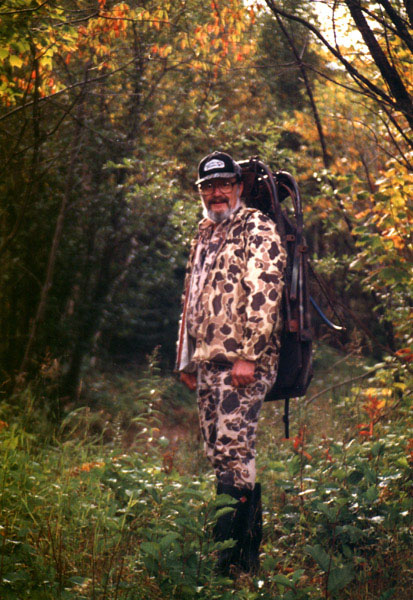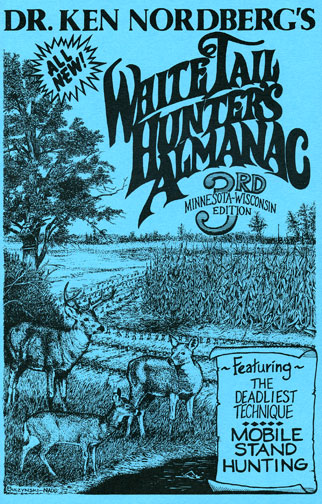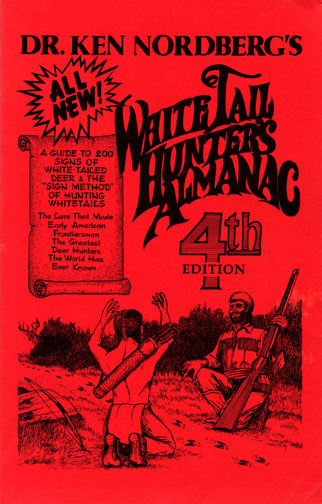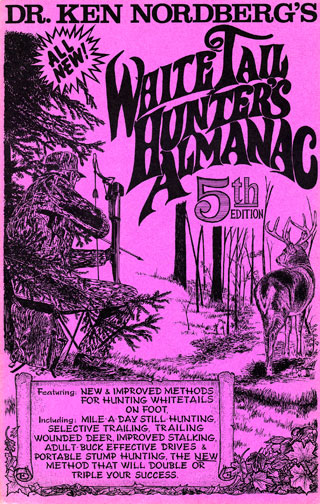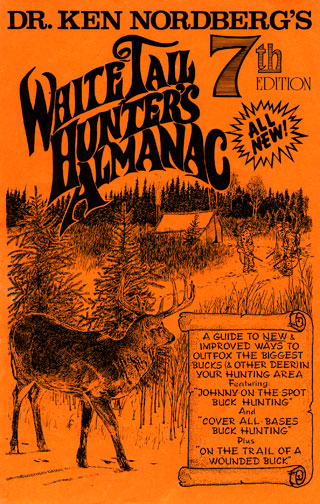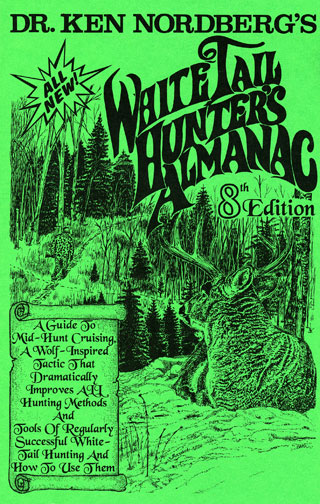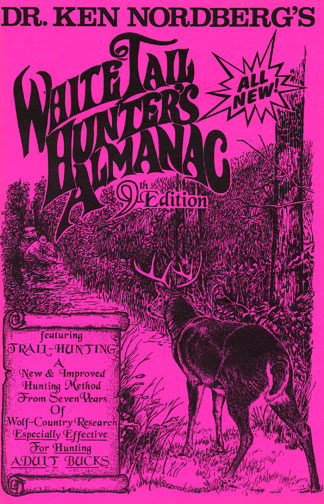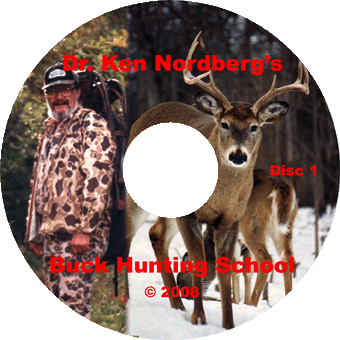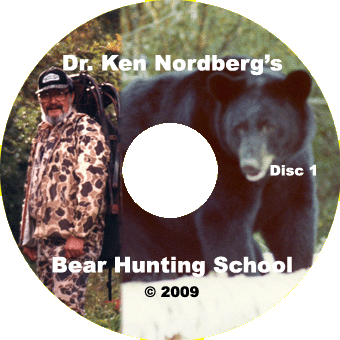Some Valuable Last-Minute Tips
By Dr. Ken Nordberg
[The following is the another of many older articles that will appear on my website. This is article was published in Midwest Outdoors in November of 1997 — referring to the 1995 season. Please share what you learn from these articles with your whitetail hunting friends.]
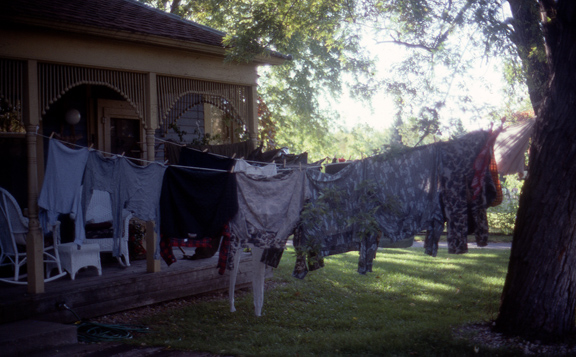
To reduce scent, Doc has his hunting clothes hanging outside.
The opener is upon us! In fact, as you read this I'll be in deer camp, getting things ship-shape for the 1995 Minnesota Firearm Deer Hunting Season beginning November 4th. If the weather cooperates — no moderate-to-heavy precipitation, no strong winds and temperatures moderate — I expect it will be a very good opener. Last year's relatively mild winter and good fawn production this year make a record harvest possible. Of course, these are not the only factors that determine how successful a hunter will be. At the individual level, luck and/or knowledge of whitetails and their signs, hunting tools used (good, of no value or bad) and skill (or a lack of skill) in using knowledge and hunting tools are the deciding factors. If you only have a couple of days to hunt, in which case you may prefer to hunt deer via group drives, or if you hunt where hunting pressure is great (lots of hunters), in which case whitetails will not be particularly predictable, you may have to settle for what luck brings you. If you have more than a weekend to hunt and/or if interference from others will be minimal, the following tips will greatly improve your odds for taking a deer; an adult buck, if you prefer.
Tip No. 1: Sit While Whitetails Move
While you are moving, whitetails easily identify and avoid you at a range of 100–200 yards. You are most difficult for whitetails to identify and avoid while sitting (while motionless). While whitetails are moving — generally until 10:00 or 11:00 in the morning and after 3:00 in the afternoon — they are easiest to identify. Logically, you should sit while whitetails are moving. This simple hunting plan is by far the best way to get opportunities to take unsuspecting (standing or moving slowly) deer at short range.
Tip No. 2: Wear a Camo Headnet While Sitting
The human head is unlike the head of any other creature a whitetail has ever seen. It lacks a muzzle and visible ears, its face is covered with bright and hairless skin and it is perched atop a very short neck. Due to its bright skin, contrasting greatly with colors of natural cover, whether it is moving or stationary, it is easily spotted and identified by experienced whitetails at great distances. A loose-fitting camo headnet (worn under your blaze-orange cap) makes the human head very difficult for whitetails to identify. It's like magic. Unless downwind, adult deer, including the wariest of bucks, will rarely recognize a seated (motionless) hunter wearing a camo headnet, even at a range of ten yards.
Tip No. 3: Don't Put All Your Eggs in One Basket
Throughout the hunting season, whitetails will quickly make whatever changes in range utilization are necessary to avoid short-range confrontations with hunters, readily abandoning unsafe portions of their ranges. Within one-half to two days, the adult deer in the area you hunt will have identified the trails and stand sites you favor and they will thereafter avoid them. Accordingly, do not limit yourself to one stand site. To enjoy the very best of stand hunting, move to a new (previously-unused) stand site (100 yards or more from any previously-used stand site) every half day (easily done when using a portable stool at ground level). [The hunters in the Nordberg Deer Camp use a combination of prepositioned portable tree stands, and previously identified and prepared ground blinds for use with portable stools. Each year, each hunter in our group typically has at least a dozen locations to sit at — with at least 1–3 new locations.]
Tip No. 4: Approach from Downwind and Sit Downwind
The only way to be absolutely certain a quarry cannot smell your airborne odors, and thus avoid you, is be downwind. Always approach a stand site from downwind, beginning 200 yards away, and always sit downwind of any trail or site where you expect your quarry to appear (also easily accomplished when using a portable stool at ground level)
Tip No. 5: Hunt (Sit) Trails or Sites Currently Frequented by Deer
After opening morning, don't waste valuable hunting time sitting near trails or sites devoid of very fresh deer tracks and/or droppings. Only sit near trails or sites currently frequented by deer, as evidenced by their fresh tracks and/or droppings (shiny), made this morning or last night.
Tip No. 6: Do Not Alter Stand Site Screening Cover
Many of today's adult whitetails, especially adult bucks, readily recognize and routinely avoid sites characteristic of human ambush sites — treestand sites with cut branches, steps, platforms, shooting lanes, etc. — whether a human is present or not. Today, then, it is best to make no changes at stand sites (cut no branches, make no shooting lanes, etc.). The hunter should make use of natural, unaltered screening cover (not one leaf removed) and natural shooting windows (openings in cover) only — nothing there to arouse the suspicion of an approaching buck.
Tip No. 7: If Breeding is in Progress, Forget Scrapes
It is almost classic in Minnesota: hunters find lots of fresh ground scrapes while scouting 1–2 weeks before the opener and decide to use stand sites overlooking scrapes. By the opener, however, the two-week period of breeding has started (starts Nov. 3–5 in Minnesota) and bucks are no longer maintaining ground scrapes (buck breeding range markers primarily intended to ward off other bucks). The bucks are spending all their time with does in estrus, trailing them within and between their bedding and feeding areas. While breeding is in progress (ending Nov. 15–17 in Minnesota), therefore, hunt adult bucks in bedding and feeding areas of adult does.
[In the early 1970's Dr. Ken Nordberg did important original biological research on whitetailed-deer that led to what is known as, “Stages of the Rut,” or preferably “Phases of the Rut.” Doc's research on “The Rut” is still critical to whitetail hunting success. It will always be critical for deer hunters to understand Doc's research on the rut. The 5 phases of the rut are:
- Rut Phase I — The Development Phase,
- Rut Phase II — The Breeding Range Establishment Phase,
- Rut Phase III — The Primary Breeding Phase,
- Rut Phase IV — The Recovery Phase,
- Rut Phase V — The Supplemental Breeding Phase.
If you don't fully understand how these phases affect whitetail deer hunting, or understand how to hunt these phases, I recommend — at a bare minimum — ordering a set of Doc's Sign Guides directly from Doc, using this order form, or from me — John Nordberg — using this link to my eBay store. One of the 12 laminated cards in Doc's Sign Guides, the Rut Calendar, summarizes the basic information on the rut. A more complete understanding of the Rut is available from Doc's many articles, books and DVDs. Doc introduced hunters to the 5 phases of the Rut in his first Whitetail Hunter's Almanac, published in 1988. Then, in 1989, in the Second Edition of Doc's famous series of 9 Whitetail Hunter's Almanacs, he extensively detailed all aspects of the 5 phases of the rut. This book permanently changed deer hunting, creating the modern era of deer hunting. At this time, both editions of these books are out of print. Like Dr. Ken Nordberg's new bear ebook, we plan to make new versions of these books as ebooks.]
Tip No. 8: In Wolf Country Key on the Dark of the Moon
Being constantly hunted by wolves, the whitetails of northern Minnesota (and all other areas where hunting pressure is great) move little by day while there is moonlight at night. This year, unfortunately, moonlight will stifle daylight movements to some degree until the last 4–5 days of Minnesota's 16-day firearm hunting season. If you don't take a deer on opening weekend, therefore, don't put your gun away. In wolf country, at least, the best days of the season will be the last 4–5 days.
Good Luck Hunting,
Doc
